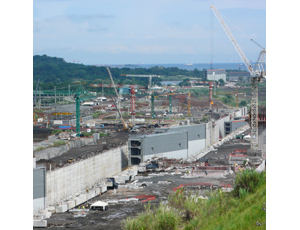
With the 100-year-old Panama Canal and its challenging third-lane expansion just miles away, engineers from around the world debated project transparency earlier this month in Panama City at an American Society of Civil Engineers conference.
In a session on “Maintaining Transparency and Integrity in the Procurement of Gigaprojects,” moderator William P. Henry, a consultant to Pegasus Global Holdings Inc. and a former American Society of Civil Engineers president, set the stage by saying that any of the players in a project from owners to engineers and from financiers to equipment suppliers can be “a source of difficulty in getting projects done in a transparent way.”
The Panama Canal Authority has a strong reputation for transparency in procurement, according to Francisco J. Miguez, executive vice president for finance and administration. He told the group that the key factor is to having “honest people leading and managing the process. If that’s not the foundation, nothing else that you put into play will solve the issue of corruption.”
Project leaders must also communicate clear rules and “include ethics and expected behavior” among them, he added, recommending a balance of power contractually between the owner and builder so that neither party can take advantage—as well as audits of their work by a neutral third party.
Enforce one single official channel of communication between the parties at the bidding stage and in the contract execution stage, he added: “There should be no gossip and no back channel of communications. To keep the process transparent, you have to avoid that.” Be fair and respectful of contractors and consultants but enforce and stick to the letter of the contract, he said.
Finally, Miguez advised, “Document as if everything is going to be argued in court—because everything is going to be argued before an dispute adjudication board or in court.”
Resolving Disputes
Attendees at ASCE’s Global Engineering Conference, which drew more than 1,000 professionals from 21 countries on Oct. 7-11, heard how the canal authority is currently working through numerous claims from its contractor consortium Grupo Unidos por el Canal. The claims go through a three-step dispute-settlement process that involves a review by the authority, an evaluation by a dispute adjudication board (DRB) in Panama and then possible appeal to an international claims court in Miami.
Eric Kerness, co-chair of the Dispute Resolution Board Foundation’s transportation committee, explained how a DRB functions in complex projects, which have high risks and potential for large claims and disputes. A DRB is an impartial group of professionals formed at the beginning of a project to try to avoid disputes and to assist in resolving them. The parties, which can be either engineers or lawyers, are neutral, have no conflict of interest and have the advantage of contemporaneous knowledge of what’s happening on the project since they board is formed at the outset.
The process can be effective, and an impartial review can deter fraud, false claims and corruption, Kerness explained. They are used on complex, lengthy duration projects. Findings are non-binding. He said 2,700 projects totaling $225 billion have employed DRBs, adding that, “Overall, 98% of the matters going to a DRB do not later go to arbitration or litigation.”



Post a comment to this article
Report Abusive Comment